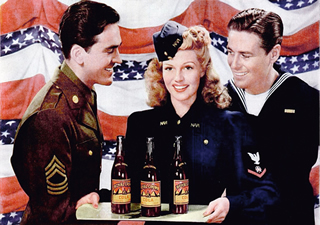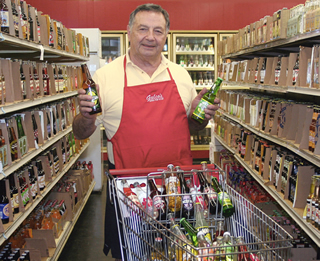That's Our Pop! - Page 2
 |
|
|
 |
|
|
 |
|
|
“When you think of soda, when you’re a little kid, when did you have them? It’s like ice cream,” he says. “You had them at parties, during holidays. Those are always good memories.”
Drink less, enjoy more. Good advice for reasons of the pocketbook as well as health, Nese suggests. “Coke and Pepsi can sell something for a quarter a can,” he notes, while a 12-ounce bottle of good quality soda from an independent bottler goes for about two dollars. But for that you get real ingredients and real cane sugar, not corn syrup.
“7 Up was the number-one selling soda in California prior to the mid-‘50s, the early ‘60s,” he says. “It outsold Coca-Cola. That’s because it was made from lemon and lime oils, not extracts. Most sodas today are cheap.”
“Nesbitts,” he says, recalling a legendary orange soda, “used wild zest, the skin of the orange, and not just an orange. A navel orange. It was, oh my goodness!”
Nesbitts, fine as it was, didn’t give soda its only oh-my-goodness moment. Far from it.
Consider the origin of this mysterious beverage called ‘soda.’ Not its prehistory in the days before the French Revolution, when Dr. Joseph Priestly in England and Torbern Bergman in Sweden used chalk and sulfuric acid to produce drinks that bubbled and pleased.
No. The real start came, where else, in America, just before the War of 1812, with the development of a machine to manufacture ‘imitation mineral waters.’ Now people could finally enjoy carbonated water without trekking into the hills after a natural source.
Soda began, ironically enough, as medicine for both body and soul. Bubbling water emerging from the ground, preferably warm and sulfurous, has seemed magical and health giving since the days of the ancients.
The road runs clear and true from the Oracle of Delphi, who prophesied above steamy mists from deep in the earth, through the great European spas at Wiesbaden, Karlsbad, and Vichy; the 19th century American spas of Saratoga Springs and Calistoga; all the way to Dr. Pepper, which in its early years in late 19th century Texas promised “vim, vigor, vitality.”
Moxie, a Maine beverage, claimed circa 1876 to relieve “paralysis, softening of the brain, nervousness, and insomnia.”
Take that, Center for Science in the Public Interest.
It was American pharmacies that started the soda fountain craze in the early 20th century, concocting cocktails of bubbly water mixed with curative nostrums to salve the sick. And many of the early sodas certainly seemed to work—and why wouldn’t they?—laced as they were with mega doses of caffeine and the extract of the coca plant, the same stuff that could be made into cocaine.
Speaking of crises in the world of soda, imagine the look on the faces of drugstore soda jerks nationwide when the federal government decreed in the Harrison Act in 1914 that coca and cocaine would henceforth be banned in over-the-counter products, including soda. (Coca-Cola stopped using coca a decade earlier.)




